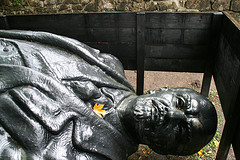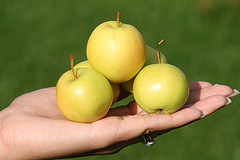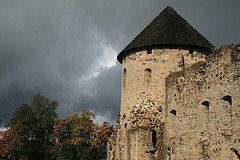Latvia: Alternative Riga, medieval castles, lots of apples, and Lenin in a box
Thursday, September 24th, 2009It’s always pretty extraordinary to fly directly from the Third World to the First World, but it was especially so on our flight from Uzbekistan to Latvia, considering how massively different the two places seem while remembering that, less than two decades ago, they were both part of the Soviet Union and, as such, the now-defunct Second World. (The original division of the globe into three ‘worlds’ was political, not economic, in nature: the First World represented the United States and its allies, the Second World contained the Soviet Union and its allies, and the Third World consisted of the remaining, non-aligned countries.) It’s hard to imagine that these two countries were once both ruled by distant Moscow, given the extreme differences in development, culture, religion, geography and just about everything else.
 And since the fall of European communism another important difference has arisen between Central Asia and the Baltics that I’ve noticed over the past few days: the attitude of both regions to the Soviet period. In a 10-minute stroll in the centre of the Kyrgyz capital Bishkek, for example, you can see at least three statues or plaques dedicated to Lenin, a statue of Marx and Engels, numerous Soviet-era buildings still adorned with the hammer-and-sickle, and a Lenin shrine at the State Historical Museum, with yet more statues of the revolutionary leader amid much pro-Soviet and anti-American propaganda – all of which almost gives you the feeling that the USSR is still alive and well in 2009. In the Latvian capital Riga, however, a poignant inscription at the former KGB headquarters describes torture and humiliation, an old city museum is dedicated to the 1940-1991 ‘occupation’ of the country, and only one government building in the whole city – the so-called ‘Stalin’s Birthday Cake’ tower – still has the hammer-and-sickle insignia on it (and not everyone’s happy about it). Even in the small town of Cēsis, a symbolic tombstone speaks of the ‘communist horror’. And as for Lenin statues, the only one we’ve seen so far was lying on his back inside an open box in the grounds of the old castle at Cēsis being pelted with hailstones, abandoned and forgotten by all but a few curious tourists. Arguably the most significant figure of the 20th century is now out of Latvian sight, and out of the Latvian mind.
And since the fall of European communism another important difference has arisen between Central Asia and the Baltics that I’ve noticed over the past few days: the attitude of both regions to the Soviet period. In a 10-minute stroll in the centre of the Kyrgyz capital Bishkek, for example, you can see at least three statues or plaques dedicated to Lenin, a statue of Marx and Engels, numerous Soviet-era buildings still adorned with the hammer-and-sickle, and a Lenin shrine at the State Historical Museum, with yet more statues of the revolutionary leader amid much pro-Soviet and anti-American propaganda – all of which almost gives you the feeling that the USSR is still alive and well in 2009. In the Latvian capital Riga, however, a poignant inscription at the former KGB headquarters describes torture and humiliation, an old city museum is dedicated to the 1940-1991 ‘occupation’ of the country, and only one government building in the whole city – the so-called ‘Stalin’s Birthday Cake’ tower – still has the hammer-and-sickle insignia on it (and not everyone’s happy about it). Even in the small town of Cēsis, a symbolic tombstone speaks of the ‘communist horror’. And as for Lenin statues, the only one we’ve seen so far was lying on his back inside an open box in the grounds of the old castle at Cēsis being pelted with hailstones, abandoned and forgotten by all but a few curious tourists. Arguably the most significant figure of the 20th century is now out of Latvian sight, and out of the Latvian mind.
Since I’ve spent the past three days posting on Facebook about how awesome it is to be in Europe after spending almost all of the last two years in Asia, I won’t beat that drum anymore here, but needless to say, it’s been very enjoyable so far. Riga is a pleasant capital, with an historic old town typical of Northern Europe with its cobblestone streets, pastel coloured houses and imposing brick churches. But the best part of our stay in the capital was probably when we took a free tour into some of the less postcard-worthy areas of Riga – past old warehouses, through produce markets and flea markets and 24-hour open-air markets, into the decaying, fire-prone ‘Little Moscow’ neighbourhood and past the aforementioned former KGB headquarters and controversial hammer-and-sickles on the Stalin-era tower. Our guide spoke of the Latvian disdain for the Russians who make up 43 per cent of the city’s population but refuse to learn the Latvian language, of the horror of the Soviet period, and many other interesting things. All in all, it was a memorable if completely different introduction to an EU capital from anything we’ve experienced before.
 After a day-and-a-half in Riga (we will return at the end of our Baltic trip for another day before flying out), we’ve spent the past two days in two small towns in the Latvian countryside, Sigulda and Cēsis. Sigulda, where we’ve based ourselves, is a nice, leafy town (especially now in autumn) with a relaxed atmosphere and a few ruined castles in its vicinity. Yet what I’ll remember most about Sigulda are the many wild apple trees all over town; whenever we walk past one, we pluck a couple of apples from it, take a bite, and walk on. Underneath some of the trees there are dozens of applies lying on the ground; in fact there’s such an abundance of apples that on one sidewalk a box full of them lay with a note asking passers-by to take one if they pleased.
After a day-and-a-half in Riga (we will return at the end of our Baltic trip for another day before flying out), we’ve spent the past two days in two small towns in the Latvian countryside, Sigulda and Cēsis. Sigulda, where we’ve based ourselves, is a nice, leafy town (especially now in autumn) with a relaxed atmosphere and a few ruined castles in its vicinity. Yet what I’ll remember most about Sigulda are the many wild apple trees all over town; whenever we walk past one, we pluck a couple of apples from it, take a bite, and walk on. Underneath some of the trees there are dozens of applies lying on the ground; in fact there’s such an abundance of apples that on one sidewalk a box full of them lay with a note asking passers-by to take one if they pleased.
 We spent most of today in nearby Cēsis. The town itself wasn’t nearly as picturesque as it was made out to be, but its AD 1209 medieval castle was pretty fantastic. When you buy your entrance ticket, the staff hand you a candle-lit lantern so you can negotiate three levels of dark, spiral staircases in the western tower, admiring the vaulted roof on the second floor and the views of the castle grounds and beyond from the top. We also climbed down a staircase into a chilling dungeon, and both of these experiences helped us imagine what the castle would have been like in its day. While we were at the castle the Latvian weather did its best to freak everyone out: the sky turned incredibly dark grey while we were at the top of the tower, it then began pouring on us (and Lenin in his box) once we got out, then came the hail (not so different from Kyrgyzstan after all), and finally some sunshine. Once we were back in Sigulda, it was mostly a lovely afternoon – and then tonight it rained some more.
We spent most of today in nearby Cēsis. The town itself wasn’t nearly as picturesque as it was made out to be, but its AD 1209 medieval castle was pretty fantastic. When you buy your entrance ticket, the staff hand you a candle-lit lantern so you can negotiate three levels of dark, spiral staircases in the western tower, admiring the vaulted roof on the second floor and the views of the castle grounds and beyond from the top. We also climbed down a staircase into a chilling dungeon, and both of these experiences helped us imagine what the castle would have been like in its day. While we were at the castle the Latvian weather did its best to freak everyone out: the sky turned incredibly dark grey while we were at the top of the tower, it then began pouring on us (and Lenin in his box) once we got out, then came the hail (not so different from Kyrgyzstan after all), and finally some sunshine. Once we were back in Sigulda, it was mostly a lovely afternoon – and then tonight it rained some more.
After an enjoyable few days in Latvia, tomorrow we travel to Estonia, the northernmost of the three Baltic states. Our plan there is similar to what it was here: to spend two or three days in the capital, Tallinn, and two more days in a smaller town or two.
